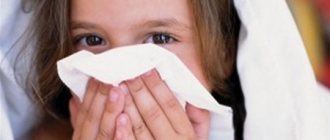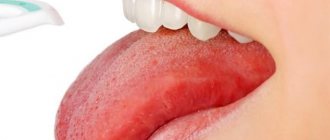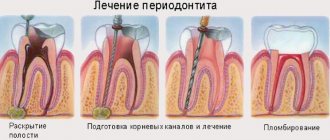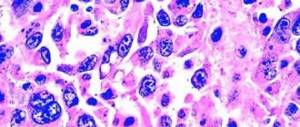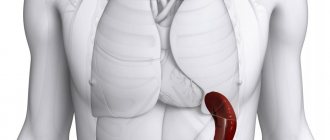Allergy to cold - does this really happen? This type of allergy is quite rare, but those suffering from it are neither cold nor hot from this news! (I apologize for the pun). The golden autumn time is slowly coming to an end, and now the real winter is gradually beginning to take its rightful place.
For some, this time is so wonderful and magnificent, wonderful and unforgettable. And for some, it brings continuous unpleasant surprises, which for most people results in diseases caused by viral infections, and some “lucky” people even develop such an exotic problem as an allergy to cold or cold allergy.
And it is worth noting that over time, such cases are becoming more common. It is difficult to name the true reason for the development of this type of allergy; perhaps it is due to the terrible state of our ecology or the quality of modern food products. But the very fact of its existence is undeniable, and people really suffer from it.
The manifestation of this allergic reaction is somewhat different from the others, so cold allergy (as it is also popularly called) is considered a pseudo-allergy. After all, in fact, there is no allergen as such in the cold or in the air, and the body’s reaction occurs precisely to the physical factor of cold.
Causes of allergies to cold
As we said above, it is very difficult to speak unambiguously about this type of allergy due to the absence of the allergen agent itself. This means that the body does not produce the necessary antibodies at all, as is the case with pollen or house dust.
But with all this, cold is the trigger that causes immune disruptions in the body’s cells, which subsequently results in a violation of their integrity and the rapid release of histamine, a companion of allergic reactions.
Also, reasons that increase cold allergies can be:
- hereditary predisposition,
- intoxication of the whole body,
- chronic infections such as tonsillitis, pyelonephritis, caries,
- as well as helminths, disorders of the gastrointestinal tract and liver,
- stress
- and improper medication use.
Prevention
Prevention of any type of allergy is a healthy lifestyle and proper nutrition. You need to try to choose a place of residence so that there are no factories nearby that produce harmful emissions. It would be ideal to move to the countryside, which, unfortunately, is not suitable for everyone. Do not abuse food additives and medications. But if you inherited a cold allergy, then there is nothing you can do about it and you just need to either move to a country with a warmer climate, or learn to behave correctly in the cold, and also control your illness from a specialist.
Main symptoms of cold allergy
External signs of an allergy are the affected areas of the body, which have dense pinkish-red rashes, swelling, and blisters, accompanied by severe and unpleasant sensations of itching and burning. Most often, this resembles a nettle burn, which is why this type of allergy is nicknamed “ cold urticaria .”
The worst thing is that cold allergy symptoms can appear not only in severe Epiphany frosts, but also with a slight drop in temperature and even with strong winds or drafts.
Since the focal points of symptoms are the more exposed areas of the body, the allergy primarily manifests itself on the arms, hands and face, which are minimally protected from the cold. But in extreme cases, its symptoms also appear on the forearms, which do not have a sufficient number of fat and sweat glands, without which the body reacts to cold twice as quickly.
Other manifestations include inflammation of the skin of the lips, sudden allergic runny nose, sneezing, lacrimation, weakness, headaches and even bronchospasm (difficulty breathing). In more serious forms of development, the disease may include: increased body temperature, tachycardia, severe shortness of breath and sometimes vomiting.
When snow or cold rain gets on the surface of the skin, a more intense reaction of the body to cold may occur, which will be accompanied by a rash of red, swollen blisters with clear liquid, which sometimes leads to inflammation of the lip tissue and swelling, called in medicine “ cold cheilitis .”
Diagnosis of cold allergies
Diagnosis of an allergy to cold, like any other allergy test, must be carried out in a medical center, where there are all the means and capabilities to provide immediate assistance.
List of laboratory tests for diagnosis
- General blood analysis;
- General urine analysis;
- Blood chemistry;
- Identification of lymphocytes sensitive to cryoglobulin;
- Skin tests (to exclude concomitant allergies).
- Provocative test with an ice cube;
- TempTest.
What do these tests show?
General blood analysis. The results of a complete blood count will help detect an increased number of white blood cells, eosinophils and ESR (erythrocyte sedimentation rate). These changes indicate that an allergic process is occurring in the body. However, it is not correct to draw conclusions only on the basis of a blood test, since the same results are characteristic of helminthic infestation.
General urine analysis. An increased protein content in the urine indicates a possible inflammatory process of the urinary system, for example, glomerulonephritis, which develops as a complication of allergies.
Blood chemistry. This analysis will show increased amounts of circulating immune complexes, acute-phase inflammatory proteins, and an increase in total immunoglobulin E levels.
Such changes confirm an allergic reaction in the active phase, but do not provide accurate information about the allergen.
Identification of cryoglobulin-sensitive lymphocytes. If the test results are positive, this means that the cold is the cause of the allergy.
Skin tests. Skin tests are performed if there is doubt that the cold caused the allergic reaction. Quite often, lymphocytes sensitive to cryoglobulin cannot be detected in the blood.
And if there is no important evidence of the body’s reaction to cold, then doubts are understandable. Therefore, it is necessary to make sure that the allergy is triggered by cold and is not a cross-reaction to some other allergen.
Duncan test or ice cube test. Cold sensitivity testing is usually done by placing an ice cube on the skin for a few minutes. If the reaction to the cold is positive, the area where the skin comes into contact with the ice will become red, swollen, and may develop a rash.
TempTest Helps determine the body's overall sensitivity to low temperatures. TempTest differs from the ice cube test in that it can not only detect cold urticaria, but also determine what temperature range causes symptoms.
The patient places his hand on the device panel, equipped with thermal film, for 5 minutes. Thermal film continuously generates the entire range of specified temperatures. Using this procedure, the threshold temperatures for the formation of cold urticaria are determined.
Treatment of allergies to cold
If the basis for the appearance of cold allergies is internal disorders of the human immune system, as well as problems associated with the functioning of internal organs, for example, stomach problems, dysbiosis, ulcers, inflammation of the gallbladder, hepatitis, problems of the maxillary sinuses, then the usual approaches to its treatment are not always effective.
For example, taking antihistamines and other antiallergic drugs before going outside can only bring temporary relief to the patient. Therefore, in order to successfully combat cold allergies, it is necessary to eliminate its root cause.
This means that first of all you need to go for a consultation with an allergist and gastroenterologist to examine your entire body. Based on the results, the doctor will prescribe the appropriate treatment for you and choose the right diet, which is extremely important in this situation. The list of essential medications includes enzyme, antiparasitic and choleretic medications that protect your liver and normalize your stomach.
Another very effective method for treating cold allergies is to carry out several courses of drinking mineral water, such as “Essentuki No. 4” or “Smirnovskaya”, which must be consumed hot, 100 g each. half an hour before each meal. But this method must be discussed with your doctor, since it is extremely individual and is not suitable for everyone.
You all probably know how beneficial proper hardening is for the body. Prepare two baths with cold and warm water and begin to alternately dip your brushes into different containers for 30 seconds each. Perform 3 circles, completing the procedure with a cold phase.
Treatment
There is no treatment for cold allergies as such. You can only avoid cold and stop the production of inflammatory mediators. Why were drugs developed that suppress the action of free histamine? Today there are 3 generations of antihistamines.
The first generation is the well-known “Suprastin” and “Diphenhydramine”. At one time they revolutionized medicine, but they are not ideal, since the connection with H1 receptors they enter into is reversible. Their advantages are that they have been used for a very long time and are time-tested, and the effect is strong and occurs within 20 minutes. But they have many side effects:
- lethargy and drowsiness;
- muscle hypotension;
- tachycardia;
- dry mucous membranes;
- temporary vision problems;
- constipation and urinary retention.
They are also poorly compatible with psychotropic drugs and alcohol. And they only last for five hours. They are good for cases when you need a quick and immediate effect, but are not suitable for constant use.
2nd generation - Clarotadine, Zyrtec and Claritin. They already have fewer side effects. They do not affect attention and muscle tone, but still affect the cardiovascular system. People who have problems with it are prohibited from taking it. Their effect lasts for about a day, and the therapeutic effect can last up to a week.
The 3rd generation is “Fexadin”, “Fexofast”, “Erius”, “Dezal” and others. Pharmaceuticals define them as third-generation H1 histamine blockers. They do not affect attention, muscle tone or the cardiovascular system in any way and are approved for use by people with chronic heart disease. Symptoms are relieved for a long time. To date, this is the best thing that has been created against chronic allergies.
There are more antihistamines on the market, but only an immunologist-allergist should prescribe them and select the dosage. After all, each drug has its own characteristics. Some of them are suitable for children and pregnant women, but some are not. Some are contraindicated for certain diseases. Well, one last thing: you need to choose a drug that is compatible with those you are already taking.
Treatment of cold allergies on the hands and face is accompanied by the use of local ointments. If the case is not serious, Locobase Ripea, Emolium and other creams from the series for atopic skin are suitable. If manifestations of allergies in open areas of the body have already entered the inflammatory stage, then sometimes it is advisable to use hormonal ointments such as Hydrocortisone. This ointment for cold allergies contains synthetic corticosteroids, due to which it works quickly and effectively, but has a number of side effects. It is used only in cases where the benefits justify the negative impact on the body.
Preventing cold allergies
Unfortunately, we are not able to influence weather conditions, so our main task is to reduce their negative impact on the body.
Here are the basic rules that you should strictly adhere to:
- Choose clothes made only from natural fabrics. The best option is cotton, which does not cause allergies.
- Clothes should always be dry. If you get wet outside, be sure to change clothes.
- In cold weather, always use chapstick.
- 30 minutes before going outside, apply a special cream with UV protection to the skin of your face and hands.
- Your wardrobe must include warm gloves, a hat, a scarf, high winter boots, a sweater and insulated pants.
- In cold weather, avoid using various alkaline-based body scrubs and soaps.
- Before going outside, about half an hour, warm yourself up with warm tea.
- If possible, limit your intake of coffee, chocolate, smoked meats, citrus fruits, strawberries and pineapple. And be sure to skip the ice cream.
- Before eating food from the refrigerator, it must first be warmed to room temperature.
- Add to your daily diet foods that are essential for any body (and also rich in omega-3 fatty acids), such as nuts, fish and olive oil.
- When blisters appear on the skin, they must be treated with brilliant green.
- For severe and unbearable itching, apply a lotion of baking soda solution to the affected areas of the skin.
What does winter allergies look like in an adult?
Symptoms of allergies that occur during the cold season appear as soon as the air temperature drops significantly. To start the main processes of the disease, it is necessary that the thermometer drop below +4.5°C, although there are often cases of the disease occurring at higher temperatures. Humid air and windy weather are common conditions for the massive manifestation of an allergic reaction during the cold season.
Meanwhile, even the symptoms of the disease are individual. They differ in intensity and nature of manifestations. Depending on the general condition of a person and the length of his stay in a cold environment, the manifestations of the disease can have varying degrees of severity. Chronic course is one of the rare forms into which an allergy to cold can develop.
Symptoms of allergies that occur during the cold season appear as soon as the air temperature drops significantly
Symptoms in adults are most often noted as:
- hyperemia and dense pink rashes on the skin;
- swelling and pronounced itching in those areas of the epidermis that were in contact with cold;
- blisters, urticaria (occurs not only on the hands and face, but also on the knees, thighs, legs);
- bruises at the site of the rash;
- general malaise, weakness of the body;
- shortness of breath and low blood pressure.
Winter allergies are often accompanied by allergic rhinitis. Running nose, sneezing and swelling occur under the influence of rapidly produced histamines in the body. Breathing becomes difficult when outside, but as soon as the patient returns to a warm room, the swelling disappears and the person can breathe normally again. Along with rhinitis, a pathological reaction to cold is often accompanied by the phenomenon of allergic conjunctivitis. Its manifestations include sensations of pain and discomfort in the eyes, lacrimation and photophobia.
What complications can there be with allergies from cold?
With a systemic allergic reaction, doctors note an increased danger to the patient’s body caused by systemic damage to the body. Severe symptoms of winter allergies include:
- Chills.
- Presyncope, loss of consciousness.
- Heart rhythm disturbances.
- Swelling of the limbs, neck, torso.
- Feeling of throat constriction, difficulty breathing.
- Dizziness.
With a systemic allergic reaction, doctors note an increased danger to the patient’s body caused by systemic damage to the body
With a sharp decrease in blood pressure, the patient may faint and go into shock. In this case, the lack of urgent medical care can lead to death.
Allergy to cold water
Unfortunately, people who are allergic to cold are also susceptible to allergic reactions to cold water. Therefore, you are strictly prohibited from taking cold baths or showers. Any hardening of the body is also contraindicated. After all, this type of allergy can be extremely dangerous for human health with the most unpredictable consequences.
Therefore, be extremely careful, because even a small sip of cold water can cause severe swelling of the throat and abdominal pain in a person.
In conclusion, I would like to advise you to be careful and attentive to your health, because a disease detected in time can be quickly cured without serious consequences for the body!
Reasons for the development of a cold allergic reaction
Winter allergies are a disease that differs significantly from the etiology of hay fever, dermatitis, urticaria, conjunctivitis, etc. Unlike these pathological conditions, it cannot be acquired. The disease is not contagious and does not have a chronic form; in addition, hereditary transmission of the disease is also excluded. Patients often suffer from manifestations of the pathology for 2-3 winters, and with correct therapy, allergies in the cold season go away forever.
For what reason the disease develops, no specialist can yet say for sure. As a rule, doctors explain the origin of the pathology by the increased sensitivity of the epidermis, which arose against the background of weakened immunity.
Provoking factors for the development of the disease can be:
- external use of cold water (for example, washing dishes, swimming in ponds, bathing);
- consumption of cold foods and drinks;
- a sharp change in temperature (when leaving the house in windy frosty weather).
In addition to the above-mentioned “triggers”, due to which an allergy to cold appears, the causes of its occurrence may also be hidden in long-term use of antibiotics, helminthiases and against the background of infectious pathological processes. The disease causes extreme stress, which in itself is a significant reason for weakening the nervous system and the entire body as a whole.
Allergy to cold often develops in the presence of:
- individual immunity to certain foods;
- dermatological diseases (eczema, psoriasis, neurodermatitis);
- infectious diseases (measles, mumps, rubella);
- pneumonia;
- endocrine system disorders;
- lupus erythematosus;
- oncological processes;
- chronic diseases of the gastrointestinal tract.
Treatment of an allergic reaction caused by cold
Treatment of allergies to cold is carried out comprehensively, but the fundamental principle of therapy is the exclusion of contact with a cold environment. During the period of exacerbation of the disease, you should refrain from walking in frosty and windy weather, and avoid prolonged exposure to fresh air. At the same time, if you have to go outside in any case, you should take care of protecting exposed skin. Gloves and scarves are a must-have for someone who suffers from winter allergies.
Getting rid of a disease is a long and not easy process, but it is still possible to get rid of the disease forever. The disease can be completely cured with timely treatment and correctly selected therapeutic methods. In addition to complex medicinal effects aimed at eliminating manifestations, you can fight allergies to cold with the help of physiotherapeutic procedures and folk remedies. It is equally important to follow the rules of a healthy, balanced diet and follow basic preventive principles.
Antihistamines in the fight against disease
Unfortunately, there is no special pill for cold allergies. In the treatment of skin pathologies, several types of drugs play an important role. Oral antihistamines are usually prescribed in drop and tablet form, as well as in suspension form. They are aimed at eliminating symptoms (itching, swelling, erythema, swelling).
The most effective antiallergic drugs are:
- Fenistil;
- Zodak;
- Tavegil;
- Claritin;
- Suprastin;
- Cetrin;
- Loratadine;
- Clemastine.
Unfortunately, there is no special pill for cold allergies
External hormonal and antibacterial agents
To get rid of an allergy to cold, which leaves unpleasant painful rashes on the epidermis of the face and hands if it spreads rapidly, you will have to use hormonal medications. Corticosteroids quickly block the development of a pathological reaction, producing a local anti-inflammatory effect, thereby accelerating the healing process. As a rule, such medications are used externally. Creams and ointments for allergies (including cold) with hormones have a lot of contraindications and side effects, so they can only be used with the approval of a specialist.
Most often, doctors prescribe:
- Advantan;
- Beloderm;
- Dexamethasone;
- Hydrocortisone ointment.
In case of scratching, to prevent bacterial or fungal infection, the doctor may prescribe antibacterial and antifungal agents, including:
- Levomekol;
- Erythromycin ointment;
- Ficidin;
- Gentamicin fry;
- Levomycetyl alcohol solution.
Other drugs and methods in the therapeutic complex
Everyone who has had to deal with problematic manifestations of the disease at least once is interested in how to cure an allergy to cold. Another group of medications includes bronchodilators and drugs aimed at eliminating rhinitis and conjunctivitis.
They are also used for medical purposes, if necessary, according to the instructions and prescription:
- Salbutamol;
- Vibrocil;
- Sanorin;
- Analergin;
- Cromohexal;
- Lecrolin.
In case of intense damage to the extremities by allergic rashes, experts recommend undergoing a course of physiotherapeutic procedures. Treatment for cold allergies most often involves exposure to ultraviolet rays. This technique has a positive effect on the nervous system, metabolic processes, and improves local immunity.
For winter allergies, ultrasound is used. In combination with segmental effects, it is used locally during one session on the affected areas.
Electrophoresis based on medicinal substances will also help speed up the regeneration of the upper layers of the epidermis:
- Calcium;
- Suprastina;
- Histamine;
- Diphenhydramine.
What to do to avoid getting sick
The causes of allergies to cold, which are quite common, especially in children and people with fair sensitive skin, are still not fully understood, which means it cannot be cured. Therefore, before going outside, especially if the thermometer drops below zero degrees, try to protect exposed skin as much as possible - your hands and face.
- Wash your face only with warm water, do not take a contrast shower or drink cold drinks.
- Approximately half an hour before leaving the house, apply a nourishing protective cream with oils to the skin of your face and hands. You can also use non-comedogenic oils in their pure form. For example, cocoa butter, which is rich in fatty acids, including oleic acid. The oil will create an invisible film on the skin, protect against low temperatures and eliminate dryness and flaking.
- Be sure to wear gloves and a hat. Frost is harmful not only to the skin of the face and hands, but also to the hair follicles. Negative temperatures provoke a narrowing of blood vessels, which leads to a reduction in nutrition and oxygen saturation of the hair, weakening of its growth and hair loss.
- Do not try to harden your skin by accustoming it to the cold. This will only make it rougher and thicker to protect itself from the environment.
- In the cold, try to breathe through your nose rather than your mouth. And best of all, breathe through the scarf.
- If your cold allergy worsens, consult your doctor. He will prescribe you antihistamines: tablets, ointments and nasal drops.
Therapy for this disease is carried out in 2 directions at once. First, it is necessary to relieve the unpleasant symptoms of the pathology, for which local products are used that soften and heal the skin and relieve inflammation. At the same time, you should find out why the allergy to cold occurred - treating the cause of the disease will help to completely eliminate it. Therapy should be carried out by a qualified specialist.
There are corticosteroid and non-hormonal local remedies that eliminate inflammatory processes and restore the skin. How and how to treat allergies to cold is prescribed by the doctor. Independent use of hormonal, antimicrobial and other potent medications is dangerous and can cause complications. Allergy to cold can be treated with the following creams:
- Fenistil;
- Triderm;
- Gistan;
- Elokom;
- Sikorten;
- Advantan;
- Soventol;
- Bepanten and others.
For severe dryness of the epidermis, peeling and cracking, local preparations with a fatty base are better suited. Treatment of cold allergies is effective using the following ointments:
- We see;
- Fluorocort;
- Dermovate;
- Flucinar;
- Triderm;
- Stellanin;
- Elokom-S;
- Sinaflan and analogues.
Alternative medicine offers several effective methods of getting rid of the symptoms of this disease. Before treating cold allergies using traditional methods, it is advisable to conduct tests on the body’s sensitivity to the components of the recipes. Many herbs and foods can also trigger an inappropriate immune system response. Allergy to cold is accompanied by significant damage to the skin, so it is important to simultaneously use products to heal and protect it.
Traditional healers additionally recommend using simple ways to protect the skin from wind, frost and humidity. Before leaving home (1-3 hours before), it is necessary to lubricate all exposed parts of the body and face with the following products:
- bear or badger fat;
- petrolatum;
- Shea Butter;
- glycerol;
- corn, sesame oil.
It is possible to cope with the considered pathology only by finding out the causes of its occurrence. An allergic reaction to cold is a consequence of some other disorder in the body. If you eliminate the factors that provoke a negative response from the immune system, all symptoms of the disease will disappear.
Preventative measures to prevent illness
Prevention of allergies from cold is a set of protective measures that will help avoid exacerbations during the cold season. Those who have never been affected by the disease in their lives should not relax - when at least one of the predisposing factors appears, the risk of developing pathology increases several times.
In general, it is not difficult to prevent allergies from cold; you need to adhere to simple preventive measures, reminiscent of protecting the body from frostbite and colds:
- Half an hour before walking outdoors in cold frosty weather, be sure to apply nourishing moisturizers to exposed areas of the body.
- Men and women should not forget about wearing thermal underwear, tights, hats, scarves and gloves. When choosing things, it is important to pay attention to the quality of fabrics: wool and synthetics should be avoided.
- Cold allergy is a direct indication for reducing the duration of walks in order to prevent hypothermia.
- Hardening is an excellent measure for preventing winter allergies, but it is necessary to start dousing in the summer, gradually reducing the water temperature.
- When leaving home, it is not advisable to wash your face or wash your hands first. Soap will remove the protective film created by the body from the surface of the epidermis, exposing the skin to the harmful effects of cold.
To prevent illness, you need to eat right. The diet should be balanced, i.e. contain sufficient quantities of proteins, carbohydrates, and fats. Any dishes that have the minimal possibility of irritating the mucous membranes of the gastrointestinal tract should be completely excluded. These include fried, fatty, spicy and salty foods. It is necessary to hold off with citrus fruits, honey, chocolate, and smoked meats. At the same time, it is better to introduce sea fish, seafood and olive oil into the diet along with increased consumption of fresh vegetables and fruits - they are enriched with amino acids that are most valuable for the skin.


